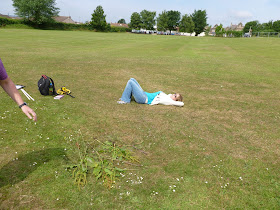.JPG)
It is late June now and the
perennial flower meadows in Reading are in full bloom, alive with pollinators and other insects. The most obvious flower in the meadows is ox-eye daisy (
Leucanthemum vulgare) with its big white flowers with a yellow center.
Other plants which are flowering at the moment are for example birds-foot trefoil (
Lotus corniculatus) with its small yellow flowers which often have a red tinge, pink-flowered musk mallow (
Malva moschata), viper`s bugloss (
Echium vulgare) with its brilliant blue flowers, red and white clover (
Trifolium pratense and
T. repens) and wild carrot (
Daucus carota). Pollinators love the flowers and if you are standing beside the meadow you can hear them buzzing everywhere. We have also seen quite a lot of small grey-green and blue damselflies as well as interesting-looking solitary wasps in the meadows.
.JPG) |
| A solitary wasp |
.JPG) |
| Wild carrot in our meadow in Meadway Recreation Ground |
.JPG) |
| Birds-foot trefoil (Lotus corniculatus) |
.JPG) |
| Musk mallow and viper`s bugloss in the Portman Road meadow |
.JPG) |
| A sea of ox-eye daisies in Westfield Road Recreation Ground |
.JPG) |
| A pretty rose chafer beetle |
.JPG) |
| Wild carrot and ox-eye daisies |
.JPG) |
| A tree bumblebee (Bombus hypnorum) |
.JPG) |
| Bumblebees (here: Bombus lapidarius) like the ox-eye daisies |
.JPG) |
| Our meadows are buzzing with pollinators |
.JPG) |
| Red - and white clover growing in the Meadway Recreation Ground meadow |
.JPG) |
| Our meadow along Portman Road looks really nice |
.JPG) |
| Bombus pratorum on viper`s bugloss |
.JPG) |
| A small tortoiseshell butterfly |
.JPG) |
| White ox-eye daisies with pink musk mallows and blue viper`s bugloss |
.JPG) |
| We have seen a lot of these small damselflies in the meadows |
The
annual flower meadows still need a bit of time but the first flowers are opening now as well. You can see small white-flowered and honey-scented sweet alyssum (
Lobularia maritima), taller white-flowered white wall rocket (
Diplotaxis erucoides), pink-flowered virginia stock (
Malcomia maritima) and in some meadows the first orange californian poppy flowers (
Eschscholzia californica).
 |
| Sweet alyssum flowering in the annual meadow in Palmer Park |
 |
| A solitary bee visiting sweet alyssum flowers |
 |
| Californian poppies and borage in the Victoria Recreation Ground meadow |
 |
| A nice hoverfly on sweet alyssum flowers |
 |
| Andrena haemorrhoa likes the sweet alyssum as well |
Read more about the flower meadows
here. If you want to visit the flower meadows have a look
here to find their locations in Reading. Best time to visit the perennial meadows is from June to August. Best time for the annual meadows is from mid/end July to September.



















.JPG)
.JPG)
.JPG)
.JPG)
.JPG)
.JPG)
.JPG)
.JPG)
.JPG)
.JPG)
.JPG)
.JPG)
.JPG)
.JPG)
.JPG)
.JPG)
.JPG)

















